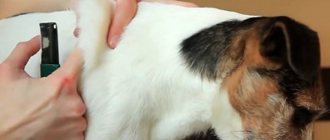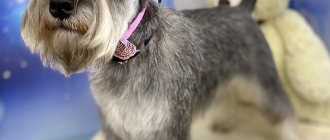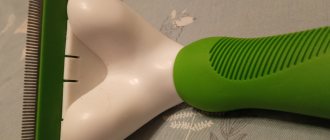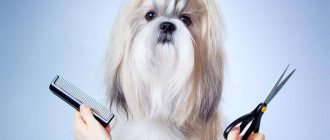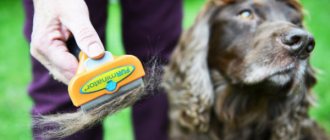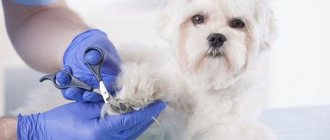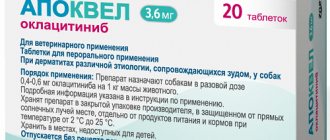Each dog's coat is unique, but based on general characteristics, all breeds are divided into three types: long-haired, short-haired and wire-haired. The latter type is distinguished by the loss of the normal molting process. If in some pets the old, thinned fur is replaced by a new and beautiful one, then in others the hairs remain in place, losing their beauty and becoming unkempt.
In order to maintain a neat appearance, it is necessary to carry out trimming - plucking out dead hair. Many owners ask questions, for example, is dog trimming painful? How to carry out the procedure at home? Does a haircut have the same effect? What breeds need cleaning? The answers to all questions are given in this article.
Why trimming is needed
Dog breeds with a hard coat - from the group of terriers and schnauzers - have lost the ability to shed on their own. Dead hairs remain in the fur coat, and to rid your pet of them, trimming is required every six months - plucking out old hairs.
First of all, this manipulation relates to hygienic procedures, since old matted fur often causes skin irritations that bring discomfort to the animal. And, of course, this procedure makes the dog’s coat neater and more well-groomed.
In principle, the owner is able to independently check whether the time has come for the pet to be trimmed. To do this, you need to lightly grab a tuft of wool, holding it with your fingers, and pull. In the case when some of the fur remains between the fingers, it means it’s time to pluck out the dead hairs.
You can do this procedure yourself if you have time, patience and special tools. Otherwise, you should contact a specialist, especially when it comes to preparing for an exhibition or competition. Only a person who knows the breed standards can do everything accordingly.
Advice
Trimming in dogs is a long, painstaking and expensive procedure. The choice of a master must be approached responsibly and seriously. Consult with the breeder or dog lovers you know. The final result of plucking depends not only on the professionalism of the groomer, but also on his ability to establish contact with the “client”. A regular procedure should not turn into stress for the dog and an endless search for “his” master. You should not take risks and trim yourself if you do not have any experience. You risk causing pain to your pet and ruining its appearance.
Is it possible to replace trimming with a haircut?
Some owners of pets with coarse hair that do not participate in exhibitions believe that only show-class dogs need such a procedure, and for their pets a regular trim is quite suitable.
But it is not so. If a dog with such a specific coat is cut, it may lose its properties forever. Even one treatment with scissors can make the wool, of course, soft and fluffy, but at the same time it will thin and weaken.
This is due to the fact that coarse hair has an interesting structure - thinner at the base and thicker at the end. After removal by plucking, exactly the same hair grows in its place. And if you cut it with scissors, it grows from the remaining thin base.
It is possible to restore the original structure of the coat, but this will require a lot of time and effort, and besides, only a professional groomer can do this.
Dogs with coarse hair appeared as a result of natural selection; hunting pets had this coat. This protected them from moisture, precipitation, wind, as well as from thorny plants and bush branches.
Of course, at that time there was no talk of trimming. Dead fur was removed thanks to the same thorny bushes through which the dogs reached their prey. Pet owners could only remove hair in places where it was more difficult to reach.
New owners are tormented by doubts: what if their pet feels hellish pain during trimming? But these fears are completely unfounded. Of course, the first procedures will make the dog nervous, because everything is new. However, animals experienced in this matter can even sleep on the groomer’s table, right while manipulating the fur.
There are several most vulnerable places on an animal’s body, trimming which will not cause pain, but some discomfort - these are the inner thighs and armpits. Sometimes dogs become restless when the head and neck areas are treated. But to a greater extent, pets tolerate such manipulations calmly, and dissatisfaction arises as a demonstration of their temperament.
Is there an alternative to stripping rough-haired dogs?
Stripping and plating of Norwich Terrier
— Maybe I shouldn’t complicate life and cut my hair? Yes, such a solution has the right to exist and I always offer it to owners whose pets do not participate in exhibitions. It is faster, cheaper and easier for the dog - solely due to speeding up the procedure, and not due to the absence of pain, as many people mistakenly think. But here you have to make a choice once and for the whole dog’s life! As the texture of the coat begins to change during haircuts, it becomes softer and often duller in color. It is almost impossible to go back to trimming. Plucking soft fur is quite a painful procedure for your pet.
Based on all of the above, my choice will always be in favor of stripping. A properly trained wire-haired dog looks incredible!
Special tools for trimming
Needless to say, it is better to give preference to professional tools of excellent quality, which are not cheap, but working with them is much easier and more enjoyable. The following equipment will be required:
- Folding table , which is covered with a rough material specifically for trimming. It is quite compact and can be folded up and put away after the procedure. The table is also suitable for use at shows if the pet is destined for a similar career. Naturally, you will have to use it for more than one year, so you should think about purchasing a high-quality table.
- Combs – a metal tool that has two sets of teeth – small and large – is suitable for trimming. They are used to comb out fur on the paws and skirt.
- Slicker brush - it is used to remove dead hairs, in addition, it is also necessary for regular combing of the pet, for styling fur when drying with a hairdryer, and for styling fur during exhibitions. It must be selected based on the type of wool; the teeth of such a brush are made of wire. Tools that are too hard are not suitable for this type of rock. And you don’t need to take a powder brush with a large surface - 5 by 10 cm is quite suitable.
- Trimming knife . They produce a great variety of similar instruments. You can purchase a knife for left or right hand use. Naturally, only practice can show what is most convenient, the main thing is that it copes with plucking and in no case cuts off hairs. To work, you will need two types of knives - one with medium-length teeth for processing the dog’s body, and the second with fine teeth to remove hair from the head, ears, and chest.
- Trimming stones are also a kind of knives, but are used at the end of the procedure or for plucking fur from puppies.
- Powder, chalk for grooming - increase adhesion to the coat, eliminate slipping, thereby simplifying the task. You can purchase special products or use regular powder for these purposes.
- A fingertip is another device for convenience; it is made of silicone and latex. Their task is to prevent irritation and calloused formations.
How to care for your instrument
The tool steel used to make the blades of some tools darkens over time. Darkening does not affect the quality of wool processing in any way. But it is recommended to wipe the blade with oil after each use (for example, oil for lubricating the blades of hair clippers). Before using the tool, remove the oil with a dry cloth.
Otherwise, care boils down to removing dirt and hair under running water and thoroughly drying with a dry cloth. Store tools in special leather cases or bags, if we are talking about a set.
Similar articles:
- Trimming stones
- Andis dog clippers
- Cosmetics Plush Puppy
- Grooming table
- Dog food container
- Dog combs
Basics of proper trimming
Like any manipulation involving animals, trimming has some nuances that it is better for owners to know about in advance.
Growing up, at a certain point, the hard coat becomes thinner; this process, on average, occurs 6 months after the plucking procedure. But even here there may be a difference in timing, based on breed characteristics.
A healthy, well-groomed pet's fur is dense, shiny, without separating into separate strands, and does not bristle. But over time, the fur becomes thinner and becomes more faded. These are sure signs of the need for trimming. All that remains is to choose whether to do it yourself, or resort to the services of a professional groomer.
Dogs belonging to the Schnauzer and Terrier varieties of medium and small sizes begin to be plucked from the age of four months at least twice, maximum four times during the year. Pedigree large puppies are trimmed from six months. The most convenient time for trimming is the spring and autumn season, when other dogs experience seasonal shedding.
If we are talking about preparatory manipulations for an exhibition, then it is necessary to carry out the procedure 1.5-2 months before the event. If wool growth is slow, treatment can be carried out 3 months before the exhibition.
You need to start plucking hair from the back of the head, moving towards the tail. The neck is trimmed first from the side, and then from above, the sides from top to bottom, and then the back. The thighs are processed only up to the area of the “hock” joints, the shoulder blades up to the elbow joint, and the tail begins to be plucked from above.
This is interesting: Bob with elongated front strands
The animal does not immediately get used to the event, at first it gets worried and nervous, in this case it is better to carry out trimming in stages, giving the animal rest.
Future owners of dogs that do not shed need to be prepared for the fact that trimming is a mandatory procedure to allow the pet to look good and avoid skin problems. If there is no desire to engage in such care, or there is no opportunity to seek help from veterinarians, then it is better to give preference to breeds that are less demanding in care.
Features for different breeds
Each breed has its own standards. The groomer’s task is to comply with all the requirements and highlight the individual characteristics of a particular dog. The procedure should not radically change the pet's appearance. The processing zones should smoothly transition from one to another.
For example, in a Scotch Terrier the withers are treated first. The procedure is carried out 3-4 months before the performance at the exhibition. The torso is processed within 2 months. Within 1 month, the lines are trimmed with thinning scissors and excess hairs that stand out from the overall picture are carefully cut off. On the eve of the exhibition, the dog is cut, the skirt is combed and shortened slightly in a straight line.
Why is dog trimming necessary?
Today, referring to the services of a dog groomer, some can imagine a kind of mannered person with exclusive scissors in his hands, allowing him to make a glamorous copy of a tame dog out of a dog.
To the delight of most, or perhaps unfortunately, this myth is far from the truth. Everything is much more trivial and mundane. Based on the concept, trimming is called nothing more than cutting wool (English: to trim). Unfortunately, the incompetence of the pioneers in the field of translating books on grooming has affected what the Russian-speaking population means by manually plucking hair trimming. Alas, this is not true.
Today, the procedure itself has become traditional, and the concept has gained recognition in society. Based on this, dog trimming requires knowledge of anatomy and a number of individual characteristics of animals. Thus, it is quite logical that the skill of trimming is highly valued among owners of wire-haired quadrupeds.
As a result of evolution, a number of wire-haired breeds have lost the ability to shed. The range of such breeds is quite wide, but eventually the old wool, of course, becomes thinner and dead. Over time, haircuts become ineffective, as the coat gradually thins and becomes softer and changes color.
In this case, the use of trimming becomes justified due to the possibility of getting rid of old dead hair. Certain breeds of dogs are not able to shed on their own, so only trimming can rid your pets of unnecessary hair. Stimulating blood circulation during the trimming procedure can improve the condition of the skin. Dead hairs lead to the appearance of tangles and rapid contamination.
How to trim a dog correctly
The trimming process can be called an art, however, it is also subject to certain rules. The cutting process begins from the withers, after which the master moves along the back, neck, followed by emphasizing the hips and sides. The wool is removed in the direction of growth, separating small strands.
It is important not to pull the fur upward. In this case, you should act firmly and decisively. For certain dogs with extremely coarse hair, even the head needs to be trimmed. At the same time, you can speed up the process by dealing with the undercoat using a cutting machine.
True, this method has some disadvantages: the undercoat is dense, therefore, as soon as it begins to outgrow, it mixes with the guard hair. If the undercoat is always cut on time, the “shell” characteristic of the pet is lost. Dead hair remains, which can easily lead to severe irritation.
Upon completion of the procedure, the undercoat is tightly packed and acquires elasticity even to the touch. Proper trimming of, say, a fox terrier involves only plucking the fur; there is no need to resort to thinning scissors. A number of craftsmen work in this mode on principle, believing that only by pinching the ideal shape is obtained.
Scissors help
The use of scissors is justified only when cutting hair between the pads of the limbs; the rest is done with a trimming knife. However, today there are not so many principled masters who meet all the canons of trimming. The highest aerobatics for a trimming specialist is considered “manual” trimming, which is a long and labor-intensive process based solely on manual labor - with fingers, without special equipment.
You can take your hat off to such people, as this is comparable to a feat. There are still reasons for this madness: the hair will not break off, and the dog will simply look gorgeous.
Secondly, this trimming technique is comparable only to dog massage. The majority of groomers tend to use scissors and clippers, greatly reducing the time they spend working with the dog, which is sometimes beneficial even for the owner himself. Often you don’t have to bother at all and trim individual parts of the body, the torso or paws.
A wirehaired dog gets a haircut at the end of his professional career, with the arrival of retirement age. The principle of “exclusively trimming” should be applied only to show stars, although in most countries animals are constantly trimmed.
Trimmed wool becomes softer and, therefore, gets dirty faster. At times, after machine shearing, especially when the coat is naturally soft, it is more noticeable. The wool changes its own structure due to the fact that during the cutting process, the scissors do not injure the hair root, leaving only a soft and thin hair part.
In addition, in the case of regular cutting, the ratio of undercoat to hair changes. A couple of procedures may well ruin the coat, up to the need to restore it to its original state, which lasts months, or even years.
Work algorithm
The process begins by preparing the animal's fur. Owners are not recommended to wash their dog the day before. Dirt and dust allow for better grip on the tool.
Masters comb the animals with a slicker brush. Then the tangles are removed and separated manually using oils. Scissors are used in extreme cases, when hairballs cannot be processed.
Trimming takes place in 3 stages:
- First, take the tool and pluck the hair, pressing it between the working surface and the thumb. The choice of device depends on the depth of the procedure and the quality of the coat. The process starts from the back of the animal's head and moves towards the tail.
- With well-honed sharp jerks, the craftsmen pull out the wool in the direction of its growth. This is completely painless for the pet; some of them fall asleep during the lengthy procedure. Treatment of the armpits, muzzle, and thighs, that is, the most sensitive areas of the body, causes slight discomfort.
- The sequence of treatment is as follows: first clean the sides, then the back and then move on to the delicate areas.
No matter how long the trimming lasts, you cannot leave the process for the next few days. It is recommended to take breaks of 15-20 minutes so that the animal calms down and continue working until its logical conclusion.
After finishing plucking, wash your hands thoroughly and treat the used tool.
Trim the dog with a clipper
To cut your hair with a clipper, you should read the instructions and cutting options in advance. First, the four-legged animal must be thoroughly washed to get rid of all the dirt in the fur. Next, you need to prepare your workplace. For this purpose, some kind of bedding is ideal, laid out within the reach of the necessary tools. After this you can start working.
All kinds of haircut options can be found in special magazines or even on the Internet. After completing the procedure, you should wash your pet again and, if necessary, adjust the haircut. If you use the machine correctly, you don’t have to worry about the safety of your four-legged dog, since it is not in danger of harm. The main thing to remember is that a dog trimmer needs:
- sharpening a dull knife blade;
- cleaning and lubricating the knife;
- monitoring the condition of the cutting heads.
It is worth understanding that each hair clipper has several replaceable knives. However, each manufacturer labels them differently. Let's say the Moser company offers a knife with a minimum height of 0.1 mm and a maximum of 9 mm.
There are two types of attachments that fit over knives: plastic and metal. Experts agree that knives are preferable to attachments, since the latter cope worse with wool. True, the master makes this choice independently.
For example, some specialists are additionally interested in the possibility of working with attachments such as a dog trimmer comb. In any case, a professional gives some advice when choosing equipment. Let's say a battery-powered machine requires an additional set of these same batteries so that an emergency does not lie in wait right during the procedure.
In principle, this is all the wisdom of choosing a trimmer, so the question of how to choose a trimmer for dogs should not drive you into a corner.
This is interesting: Molodezhka TV Series Actors Season 6
The choice of equipment for grooming animals is wide. As a rule, all of the specimens on the market can be found in a pet store. Grooming equipment is not considered expensive, but it is not possible to work without it in modern conditions. It is worth understanding that grooming is a complex service, where trimming is only a component of the entire process - hair cutting. At the same time, the appearance will be incomplete without the implementation of the entire range of services.
Dog trimming tools with descriptions
AARONCO trimming knife set
A complete set of trimming knives from the famous American groomer Sam Kohl. Premium quality! Ergonomic elongated handles are handmade from hardwood, fit comfortably in the hand and do not slip. The metal part is forged from Japanese steel of the highest quality. Thanks to the ergonomic design of the elongated handles, the knives fit perfectly in the hand, do not slip, are very comfortable to use, and the hand does not get tired when trimming with these knives much longer than when working with traditional trimming tools. The set includes 5 knives (large, medium, small, extra small, muzzle knife) and a leather bag in which it is convenient to store the tool and work, putting it on your belt and adjusting the belt to your size. The knives are already dull and ready for work - make-up artists are protected from the effect of cutting hair. You can also buy all 5 types of knives separately.
Chris Christensen STRIPPING STONE - trimming stone on a wooden handle
Natural stone is the most versatile trimming tool. Suitable for use on any type of fur, does not cut or pull hair, does not damage the skin. Pointed end for detailed finishing. It actually erases the hair of short-haired breeds: boxer, bulldog, Dalmatian, Doberman, etc. For rolling dogs, it allows for detailed processing of the hair - it captures fine hairs without breaking the hair. Removes unwanted ear and ear hair without damaging the skin or harming healthy hair.
The wooden handle makes it easy to use.
Chris Christensen STRIPPING KNIFE - stripping knife
A stripping knife is a type of knife used to quickly and effectively remove dead hair from animals. The stripping knife is suitable for any type of coat that requires periodic removal of dead hair and undercoat (“artificial shedding”), including thick coats with dense undercoat. The blade of Chris Christensen stripping knives is made of high quality polished steel, embedded in a solid wooden handle. The ergonomic design allows you to cope with the volume of work twice as fast without noticeable fatigue of your arms and hands. During the production of the instrument, the final processing is carried out manually by experienced craftsmen. The blade teeth are carefully milled and finished to perfection. This is truly the perfect grooming tool that can replace other stripping knives. Knives are provided separately for right-handers and left-handers. Length: total 15.5 cm, incl. handle 11.5 cm Type: Extra thick tooth for very soft wool - 36 teeth Thick tooth for soft wool - 26 teeth Medium thick tooth for medium hard wool - 18 teeth Rare tooth for hard wool - 14 teeth
Trimming knives Classic Stripper
Classic knives imported from Taiwan can be the best knives for new groomers. The knives have wide stainless steel blades and a wooden handle. Classic Face Knife - for processing the head, ears and detailed finishing work. Fine Stripper knife - for smoothing transitions between areas of different coat lengths and for general trimming. This is one of the most popular knives. Suitable for combing out dead fur. Coarse Stripper knife - designed for general trimming. Very easy to use - its handle fits perfectly in your hand. The manufacturer recommends this knife for any trimming. This is the best choice for beginners.
Fingertips for trimming
The fingertip makes work easier during trimming. For reusable use. Five sizes: Extra Small, Small, Medium, Large, Extra Large
Karlie – fingertips for trimming
Rubber fingertip for trimming. For reusable use. 10 pieces.
Is trimming a replacement for a haircut?
Some owners of wire-haired dog breeds believe that trimming and cutting are the same thing, without delving into the meaning of the procedures. These methods of processing wool have different purposes, so trimming cannot be replaced with a haircut.
Trimming is a forced hygienic procedure that helps remove dead hairs, thereby ensuring the growth of new hairs with the correct structure.
During the cutting process, only the tops of the coarse guard hairs are removed down to the base, but the structure of the coat changes greatly. The cut hair with a thin base continues to grow and the animal eventually breaks into soft downy thin hair. Even a single haircut of a dog can lead to irreversible consequences and loss of the type of coat characteristic of the breed.
Depending on the purpose and method of processing the coat, there are several types of trimming.
- hygienic – a mandatory procedure for wire-haired dog breeds, which is carried out at least 2 times a year during molting periods ;
- cosmetic - treatment is carried out between periods of molting in order to maintain a good appearance of the animal;
- exhibition - treatment is carried out several weeks immediately before an exhibition or competition.
By processing method:
- manual method, or plucking - plucking hairs with fingers;
- mechanical, or stripping - removal of guard hair using special tools.
There are also concepts of light and full trimming. Light trimming of the dog (performed once every 2-3 months) involves uniform, superficial removal of regrown outer hair, without affecting living hairs and undercoat.
Full trimming (if more than 4 months have passed since the last gentle treatment) involves removing dead guard hair, sometimes cutting or plucking the undercoat to a minimum length.
Types of trimmers
So, in stores you can find the following types of dog trimmers:
- vibration;
- pendulum;
- rotary;
- rechargeable.
Groomers usually use the last two types of clippers and very rarely vibrating ones, since they have low productivity and it is difficult to replace the knife on these clippers.
Pendulum ones are quite complex for home use. Rotary ones are the most powerful, they can be used for cutting dogs with very thick and coarse hair.
Sometimes, they have a cooling system, which allows you to do a haircut for a long time without stopping. If you are the owner of a not very fluffy dog, you can purchase a battery-powered one. It will easily remove unwanted hair, while it is lightweight and convenient because you are not tied to an outlet in any way and the cord will not interfere with you during the cutting process.
In addition, when choosing a trimmer, pay attention to its size. If you have a small dog, then, accordingly, take a small trimmer that will allow you to reach hard-to-reach places. You also need to check the level of noise produced; your pet may be frightened by loud sounds.
Advice! In addition to the technical characteristics, be sure to pay attention to the exterior of the trimmer: hold the device in your hand, twist it, etc. You need to choose a machine that you will be comfortable using.
But the important thing is that the trimming procedure is carried out not with the help of a trimmer (clipper), but with the help of a special trimming knife.
This is a special toothed product designed to help the groomer pluck coarse hairs evenly. Despite the fact that this is a knife, it should not be sharp under any circumstances, since its task is not to cut hairs.
This strangeness in the names is due to the fact that trimmers appeared in Russia earlier, and with the advent of a new procedure for plucking coarse hairs, it was mistakenly given the name trimming (in English this word means a regular haircut). It quickly strengthened, but do not confuse trimming and cutting. What is the difference, we will tell you further.
How does the process work?
It is better to entrust the first trimming procedure to a professional groomer. After carefully studying the work of the master, as well as receiving the groomer’s recommendations, you can treat the dog yourself. The algorithm for plucking hairs is simple, but such labor-intensive work requires patience and some preparation.
Before trimming a pet at home, first of all, it is necessary to prepare a workplace (table, cabinet) and tools. The pet does not need to be bathed before the procedure.
Step 1. put the dog on the table;
Step 2. Carefully comb the pet’s body along the hair growth path with a slicker brush and a sparse comb;
Step 3. You need to carefully separate the tangles with your fingers and try to comb them with a flat comb;
Step 4. It is better to start plucking hairs from the back of the head, or from the back, gradually moving towards the tail;
Step 5. if the groomer plucks the hairs manually, a small strand should be held with the index finger and thumb, then removed with a slight tug in the direction of hair growth;
Step 6. if plucking the guard hair is carried out using a knife, in this case the strand should be picked up with a tool held in your hand, and fixed with your thumb (with the fingers of your free hand you need to hold the skin next to the area being treated) and make a sharp jerk;
This is interesting: How to Understand What a Man Likes You
Step 7. After treating the back and sides, you should start plucking the hairs on the hips and shoulder blades.
It is better to pluck dead hairs on your pet's head manually, without using a knife, after combing your pet's head with a comb. You need to carefully remove dead hairs on the face and head. After completing the hygienic stripping procedure, the pet must be bathed in warm water, and after drying, remove any protruding hairs manually or with tweezers.
Examples before and after:
In the salon or at home?
Home care is possible, but less safe. Working on your own, you can accidentally injure your dog, pull out new hairs or form bald spots. If you have a desire to learn, entrust the first treatment to a groomer and watch his actions. It is possible to master the technique, but it will take time.
Grooming salons guarantee high-quality results and the safety of four-legged visitors. Some craftsmen work from home. This option is suitable for shy pets. Usually the excitement goes away by the third session.
If you need to prepare before an exhibition, contact a groomer. Any error that affects the breed standard will result in a lower score.
Tool overview
According to reviews and recommendations of professional craftsmen with extensive experience, the following manufacturers of grooming tools and devices have proven themselves very well:
- Macknyfe Specialties (USA);
- Greyhound Carding Knives (UK);
- Pearson Product (USA);
- Chris Christensen (USA);
- Show Tech (Belgium);
- Aaronco (USA);
- Artero (Spain).
Among the auxiliary cosmetics for grooming, it is worth paying attention to powder from Yuup Professional (Italy), Iv San Bernard (Italy), as well as crayons from Show Tech (Belgium).
Grooming table
Special folding tables for grooming with a rough surface and a bracket for fixing the animal are very convenient for grooming procedures.
Of course, not everyone decides to purchase such an accessory to carry out home hygiene procedures for their pet.
An ordinary table covered with anti-slip material is quite suitable as a home grooming workplace.
Combs
The owner of a wire-haired dog must have several types of combs in his arsenal:
- a comb with sparse metal teeth for combing hair on the head, paws, and also for untangling tangles;
- “rake” comb for careful removal of fallen outer layers of hair and dirt - this comb, unlike the fuminator, does not cut hairs or damage the undercoat;
- slicker brush for combing the undercoat and removing dead hairs.
Trimming knives
The main tool, a trimming knife or stripper , looks like a comb with metal teeth. It is designed for mechanical plucking of the dead layer of hair. The main function of this device is to hook and remove dead guard hair from the root without cutting it.
The working part of a professional stripping knife is most often made of stainless or tool steel. The knife blade must be dull - this is necessary to prevent cutting hairs and damaging the skin of the animal.
Depending on the frequency and shape of the teeth, strippings are divided into the following types:
- with a coarse notch (Coarse) for trimming dogs with thick, straight hair, representatives of large breeds, as well as for processing neglected, overgrown hair ;
- with a medium notch (Medium) for processing the body of the animal and giving it the desired shape;
- knives with frequent cuts (Fine and Extra fine) are designed for processing short hair on the neck, head, ears, for removing hairs from the undercoat, as well as for final finishing ;
- a special knife (Face) with short and fine teeth is designed to remove hairs on the face .
Thanks to the large assortment of strippers presented by manufacturers of grooming products, you can choose tools for both experienced masters and novice groomers. Beginners should prefer knives with a coarse or medium cut.
Among the products presented you can see universal 3in1 strippers, models with a folding blade, as well as professional knife sets.
Stone trimming knife
Professional groomers use special universal stone knives of various shapes and structures in their work. Using the tapered end of an abrasive bar, hair is removed from hard-to-reach places, such as the ears, groin, and anus.
The wide part of the instrument is used to treat the dog’s back and stomach. According to reviews from craftsmen, stone stripping knives are very comfortable and lightweight. Such knives do not injure the skin or damage the hair structure, but require some skill when using.
trimming stone
For final processing, a stone with a loose structure, reminiscent of ordinary pumice, is used.
The porous structure of the bar allows you to remove dirt and dead hair.
Powder or chalk for grooming
Pre-treatment of the dog's coat with professional grooming powder makes it easier to grip the coat with a tool or fingers, eliminating slipping, and also promotes better combing of the undercoat.
Grooming powder cleanses and deodorizes the coat, and also prevents skin irritation.
As an alternative to professional powder, you can use grooming crayons or baby powder.
Fingertips
Another auxiliary accessory that will protect the skin of your fingers and prevent the appearance of calluses is reusable silicone or latex finger pads.
The relief layer on the surface of the accessory improves adhesion to the strands, making the work of the master easier.
To protect your fingers from injury, you can also use disposable latex finger pads.
Shampoos, balms
After manual or mechanical treatment, the pet can be washed with a special mild shampoo for wire-haired dog breeds and balm to remove any remaining hair and dirt.
If severe irritation or rashes appear on the dog’s skin, then it is better to limit yourself to rinsing under warm water and treat the pet’s skin with antiseptic solutions “Chlorhexidine”, “Miramistin”, “Bepanten” cream, baby cream or tea tree oil.
What breeds require trimming?
To maintain the coat and preserve its basic functions, dog trimming is recommended for the following breeds:
- Jack Russell Terrier
- Parsen Russell Terrier
- cairn terrier
- scotch terrier
- norwich terrier
- Dandy Didmont Terrier
- West Highland White Terrier
- wirehaired dachshund
- english cocker spaniel
- american cocker spaniel
- Brussels griffon
- Vendean Basset Griffon
- miniature schnauzer
- miniature schnauzer
- Giant Schnauzer
- fox terrier
- springer spaniel
- Airedale
If the pet's breed is rare and exotic, then only an experienced technician will help determine the method of care.
